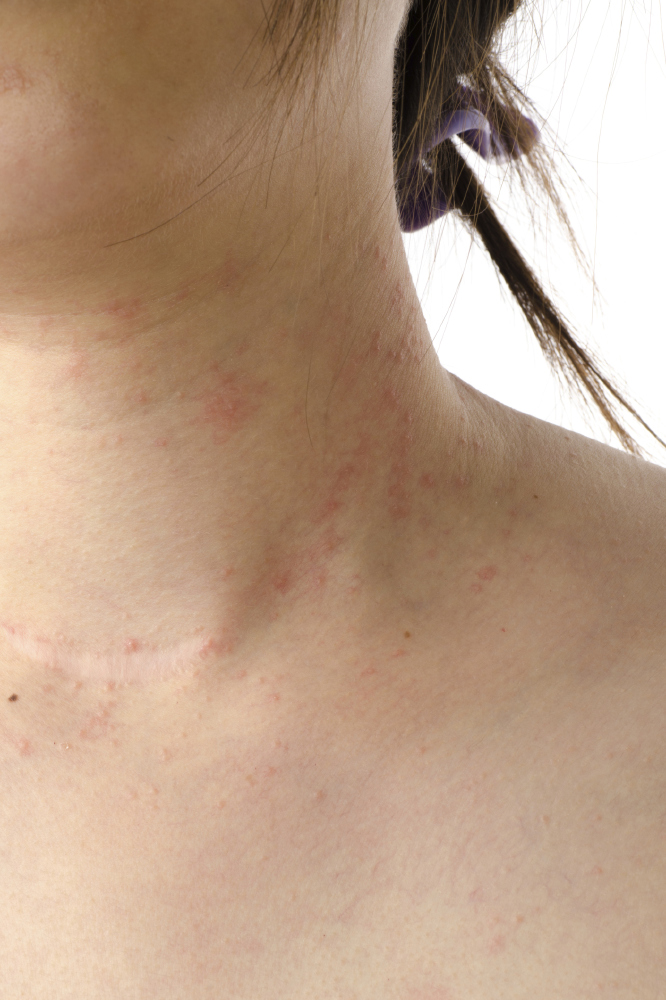
Beat eczema in time for summer and bare your skin this summer
If you suffer from eczema you may be dreading the warmer months and having to bare your skin, so we have some tips on how to beat eczema.
Maria Narsoomamode, Nurse Practitioner specializing in skin ailments and treatments at The Private Clinic of Harley Street shares her advice.
Atopic Eczema – Whole Body
Atopic eczema is a chronic, itchy skin condition that is very common in children but may occur at any age. In adults, it may present in different ways but the skin is often dryer, thicker and harder than in children. Adults commonly have persistent localized eczema confined to the hands, eyelids, nipples or all of these areas. Atopic eczema can be linked to occupational irritant contact dermatitis, i.e. skin problems caused as a result of a person’s job. This is most commonly found in people whose hands are frequently exposed to water, detergents and / or solvents, such as hairdressers, chefs or cleaners.
This type of eczema often occurs in people who have “atopic tendency”. This means they may develop any or all of the three closely linked conditions; atopic eczema, asthma and hay fever. Often these conditions run within families.
It can be triggered by a number of things. Skin irritants are one of the main causes, so anything from harsh soaps, chemicals, strong perfumes and skin care products containing fragrance and/or alcohol can all traumatise the skin. Allergies to pollen and animal hair can also cause atopic eczema to flare up and stress has also been known to be a trigger. Stress is an associating factor and can lead to scratch marks and infection.
It is important to keep the skin hydrated by applying ointments or creams regularly during the day or whenever possible. This will keep the skin moist and nourished. This is especially important during times of low humidity when skin becomes drier.
Contact Eczema - Hands and Face
Contact eczema usually affects the hands and the face for obvious reasons. Much like atopic eczema, contact eczema occurs when chemicals or physical agents damage the surface of the skin and the body is unable to repair the damage. The eczema is well demarcated with a glazed surface but there may be redness, itching, swelling, blistering and scaling of the damaged area.
A large number of cases of hand contact eczema are occupational and due to irritants, most often affecting cleaners, hairdressers and food handlers.
Seborrhoeic – Face, Scalp, nose and other areas
In this case the itchy rash appears on the areas of the skin with larger amounts of grease, so usually the scalp or sides of the nose. Dandruff is an uninflamed form of Seborrhoeic eczema which cause itching and dryness and can gradually get worse if not addressed. With persisting itching of the affected areas eczema can sometimes be triggered.
Discoid or Nummular dermatitis– Any part of the body particularly lower Legs/forearms.
This type of eczema is characterized by round or oval blistered or dry skin lesions and is most common in adults. Discoid or nummular refers to their disc or coin shape appearance on the lower legs and forearms. Visibly it feels bumpy to touch and soon the affected patches start to ooze and become incredibly itchy and often infected. When it eventually starts to heal, the skin’s surface becomes scaly leaving the skin very dry. Dry skin is usually the main cause of this condition but strong soaps and detergents also play their part
Asteatotic or eczema craquelé - Shins, lower legs, trunks and upper limbs.
This type of eczema occurs in the over 60s during the winter months and results in very dry skin. It got its French name from its “cracked” appearance. Asteatotic eczema is widely thought to be down to a lack of essential oils, over-use of soaps, low humidity and rigorous drying of the skin. The eczema appears on the shins first and manifest as dents and crevices on the skin becoming more pink and prominent. It usually looks angry but only affects the superficial layers of the skins surface so with deep moisturisation it can be easily resolved.
Pompholyx – Hands and Feet
Only appearing on the hands and feet, blisters appear and they break and weep which leaves the skin very itchy and inflamed. There are no known reasons for this type of eczema but it is thought that emotional tension, sensitivity to metal compounds (example nickel) and sweating can aggravate it.
Varicose Eczema - Legs
This is one of the most unheard of causes of eczema which usually only affects the legs. Varicose eczema is eczema that is caused by underlying varicose veins. The symptoms usually develop on the skin over and around the varicose veins. This type of eczema can be treated by dealing with the root of the problem, i.e. the defective veins.
Mr Dynesh Rittoo, Vascular Surgeon at The Private Clinic of Harley Street, says: “Not many people are aware of the existence of Varicose Eczema but it is something that can occur and is often very uncomfortable for those who suffer from it. To get rid of varicose eczema you must treat the veins beneath the skin first.”
He continues: “Treatment such as endovenous laser ablation (EVLA) is minimally invasive and can therefore be performed under local anaesthesia as a walk in walk out procedure. EVLA works to remove both the appearance of varicose veins and the discomfort caused by their presence. Once the varicose veins have been treated, the skin on the surface will also heal.”
This treatment is offered by The Private Clinic of Harley Street. www.theprivateclinic.com

